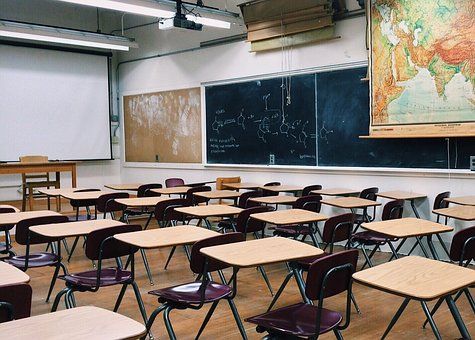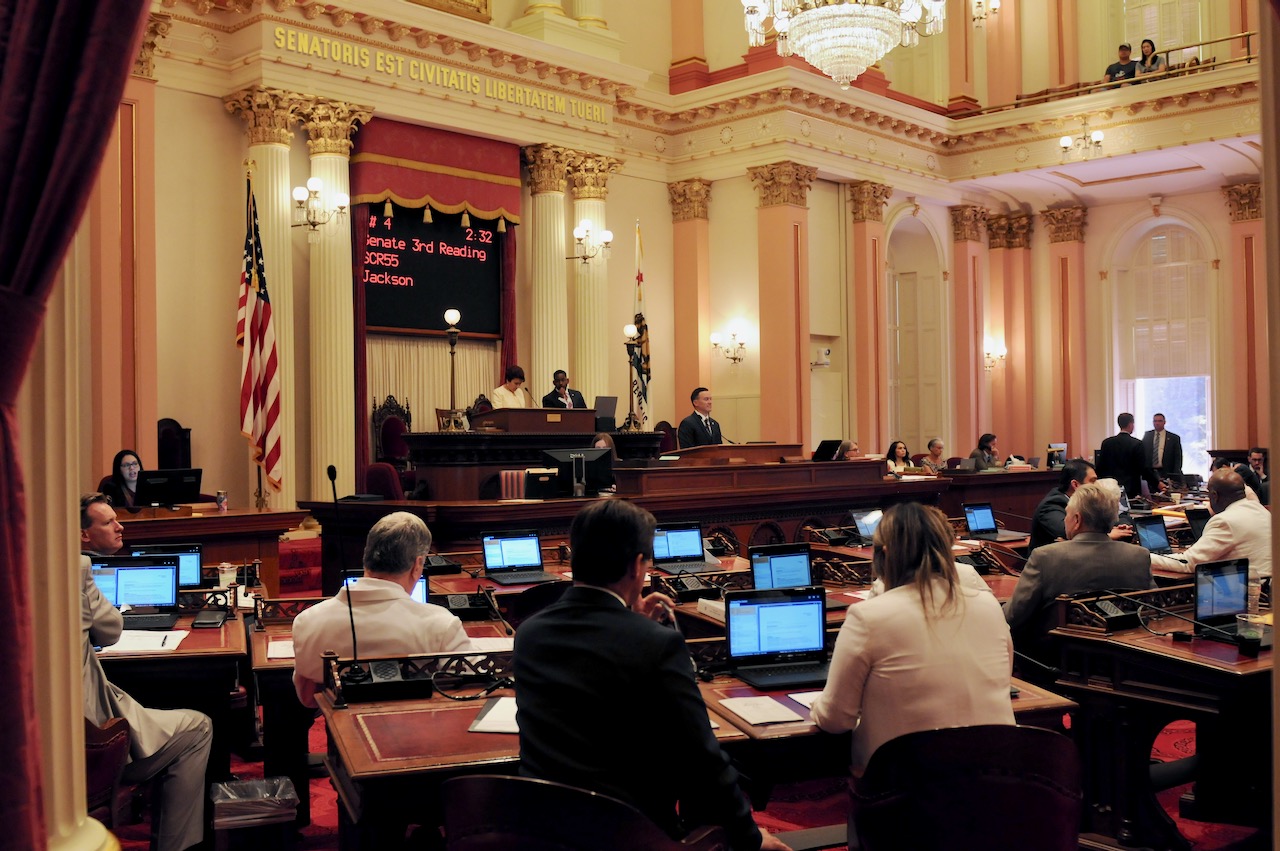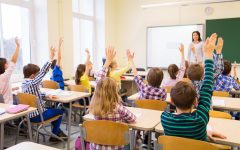
Empty classrooms (Photo: Wikipedia)
The Failure of K-12 Remote Learning Education in California
The Globe talks with numerous educators, school administrators over the failings of remote learning
By Evan Symon, October 23, 2020 2:15 am
With California school districts being two months in to a new semester of COVID-19 forced distance learning, many educators, parents, students, and administrators around California have said that, by and large, it’s not working. Some studies and surveys have found that as many as 3 out of every 4 students are now regressing in their studies.
Since the beginning of the school year, the Globe has received numerous e-mails from and have reached out to many involved in K-12 education. While there have been some positive results, most said that children are not retaining what they learned as much compared to in-school learning. Other negative aspects, such as the difficulties of internet-related learning, have harmed education in California.
“A lot of our students have poor internet connections or are using older kinds of laptops when they log in to class,” Katrina, an administrator at a school district in central California, explained to the Globe. “We have a lot of poorer students here and many cannot afford to have the sort of internet connection needed to stay fully connected to class.
“Our district, as well as many others, have been getting basic wi-fi and supplying Chromebooks for them to connect, but those have limits. I’ve had to help trouble shoot classes, so to speak, as some classes of 20 plus students had only about half able to log in sometimes. It’s a huge problem, but no one really reports on it since so much else is going on.”
Experts have said that remote learning can be effective but only if students have consistent access to the internet and if teachers have the right training and support for online learning.
“It’s a constant battle of catch up,” explained Gena Rosario, a Los Angeles teacher, in an email to the Globe. “We’ll always have at least a few students blink out during class, so we need to get in touch with them about what, if anything they missed. That means reassigning homework and reexplaining lessons. And keep in mind, this is for every class we teach that day. As soon as we’re done getting in touch, the night is over and we have to do it the next day.
“Teaching is already a stressful job. This is only making things worse.”
And the fact that some students can’t get into class remotely is causing many unusual side effects. This week in San Francisco, students have actually been threatened with arrest for not showing up to online classes, despite the students not having a good enough connection.
Special education students have been hurt the most
School districts nationwide have also been finding that younger students and those in special education programs are being hurt the most due to the need for more attention from teachers in specialized ways. California has been no exception. During calls to many school administrators in California, the vast majority named special education students as those hurt the most.
“The need attention, personal attention, to thrive,” said a special education aide in Oakland to the Globe. “School also brings many out of their shell and socializes them in a way they otherwise would not get. COVID-19 stopped all of that. The lockdowns and stay-at-home orders stopped all of that.”
Other special ed teachers noted to the Globe that many students in these programs have been struggling with remote learning as a result.
“Every month out of class puts them behind at least two or three more,” said Micah McFadden, a private special education teacher in Los Angeles.
“Out of all of them, maybe two have kept up without being there physically for them,” said another special ed. teacher in Oakland.
With normal students struggling, and special education students hurting even more in schools that have gone completely remote, school districts are noticing huge drops in enrollment. Many districts, like Berkeley, have noticed 5-10% drops already in enrolled students. Private and Catholic schools, who are better equipped and better funded for remote learning, have been flooded with new applicants this year, as have many home-school programs.
A principal for one private school in a Los Angeles suburb e-mailed the globe that their admissions rate has gone from 70% two years ago to 10% this year.
“Private schools are now like Deerfield Academy or Choate out east,” explained the principal in an email to the Globe. “Or better yet, we were as selective as CSU Chico a few years ago. Now we’re Stanford all of the sudden.
“Parents want their kids to succeed, and many have felt that their kids weren’t learning correctly or retaining knowledge like past years. Many even blamed students with bad internet connections.
“And what we have seen are more wealthy parents, the ones who stuck with public schools, are now switching to private schools. So all of these school districts, they are losing out.”
A potential future tax base, voter base loss for public schools
Nancy Lang, a former school district official in Southern California, noted that this could even have drastic consequences.
“Chances are, these wealthy families will stay in private schools after COVID-19 is over,” noted Lang. “And that’s going to make things worse for public schools. They’ll lose a big tax base, as well as voters. If their kid isn’t in public school, why vote to increase taxes?
“We’re very worried this might have an effect like public busing in the 70’s. Back then, many districts tried to even out racial disparity between schools by busing kids around to different areas to even things up racially. But parents hated their kids having such a long commute, so private schools just took over. This happened in Boston for a long time, and you can see it in California. Pasadena, for example, has very low public school enrollment because of a huge bus disagreement in the 70’s. This caused a lot of parents to go private school. So many were built that today only poor students really go to public school there, and taxpayers don’t really vote for tax raises there for schools.
“And that’s just one city. There are many more. And this, COVID-19, it’s only going to expand that to many other cities. A lot of Bay rea cities have been going that way for years, and this is the straw that broke the camels back for most.”
With grades also declining and parents feeling an increasing burden and fatigue from having their children at home, remote learning in California is not only not working, but will also most likely lead to large education changes in the coming decades.
“We need kids back in class now,” stated McFadden. “We can make schools safe for them to return to, even if it’s partial like some districts. But all we’ve gotten are no’s. And it’s only hurting them, as well as us, more.”
- Bill to Require Law Enforcement Disclosure if AI Was Used To Help Write Reports - August 7, 2025
- Gov. Newsom Files FOIA Request To ‘Expose True Cost’ Of L.A. Federal Troop Deployment for Anti-ICE Riots - August 6, 2025
- California Redistricting: How Newsom’s Plan Will Demolish Hard Fought GOP Gains - August 6, 2025





Interesting that some, if not most, of the concern is money and the loss of students. Especially in LA, the teacher’s union brought this on themselves with their insane demands. My hope is that many parents will realize that home schooling or private schools, will serve their children so much better than the indoctrination centers that are public schools.
Remote Learning:
Less time in class and teachers pushing to use “google” or some other method to gain instructional knowledge of subjects. Many kids are lost, and afraid to speak up about how lost they are because it would hamulate themselves in front of peers
Remote Learning: Less time in class and teachers pushing to use “google” or some other method to gain instructional knowledge of subjects. Many kids are lost, and afraid to speak up about how lost they are because it would embarrass themselves in front of peers
Parents understand Governor Newsome and the Teachers Union do not care about your children. Support school vouchers and leave public education.
More evidence that the Democrat-led overreaction to the 99.7% survivable virus will end up hurting them in the long run.
People are beginning to see their end-game as politically motivated, and I suspect that the blowback from the cozy relationship between the teacher’s unions and Governor Greaseball Newsom will result in a political pushback the likes of which we haven’t seen since ’72 and McGovern’s blowout loss to Nixon…
I saw two large Trump rallies today, one on all four corners of Westlake Blvd & Agoura Road and another car parade in Simi Valley!!!
And only a handful of Biden signs in a wealthy part of Westlake Village near Lake Sherwood…much quieter than in years past…
The Democrats have overplayed their hand…
Hopefully these angry parents will also get on board Newsom’s recall campaign and get this dictatorial asswipe out of CA governance.
I see so many of these kind of articles arguing about how bad distance learning is for our kids but I have to say that my kids are doing great with it. In fact, I would argue that bmy 5th grader is having her best year and that’s saying a lot because 3rd grade was a wonderful year for her. My 7th grader is just owning it. They both take personal responsibility to attend class sessions and get their homework done. When they have some difficulty they come to me and we sort it out, no different than if they were just doing regular homework. Occasionally the internet glitches or the Chromebook needs a reboot but they are now navigating through those problems on their own because I taught them how to do so. Now, do they miss their friends meeting up in school. Yes, of course, but we find ways to have them interact socially distanced by going on bike rides, walks, runs, and occasional play dates in the yard. Do I wish schools were open? Do I wish everything was fine and we could go back to our normal lives? Of course I do but look across the country and the world right now and things just aren’t normal. I understand that I am privileged to be able be here for my kids and many parents can’t be and I understand that some kids have special needs. I know some districts are allowing special needs students in small groups and one teacher to attend class with ppe which makes a lot of sense. I think for those folks that have both parents working that trying to establish mutually beneficial bubbles with another family or two or perhaps with extended family households that can offer support while others are working would be a great way to go. I get that for some people this may not work. Maybe districts can work with folks that fall in that gap to provide more support. Desperate times call for desperate measures. The other thing, my kid’s district has done a much better job this school year than last in part because they drew lessons from other established successful online schools like the Stanford Online Highschool which, btw, provides some free online resources/tips.